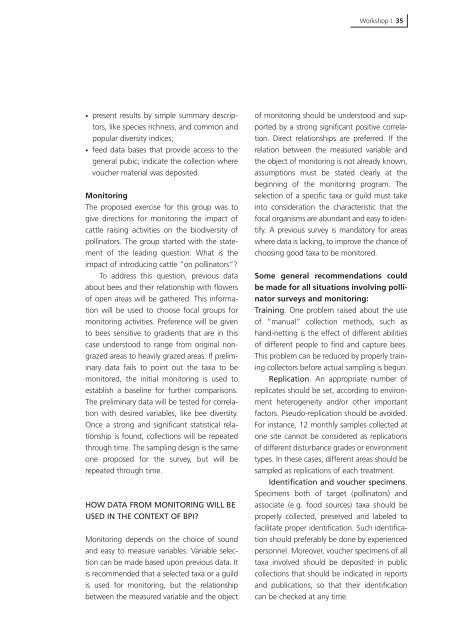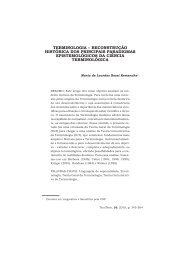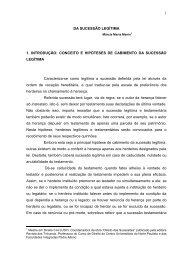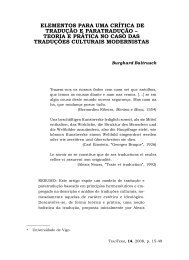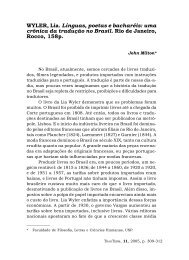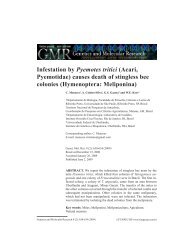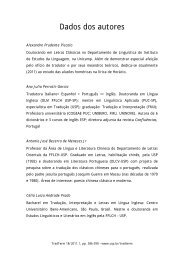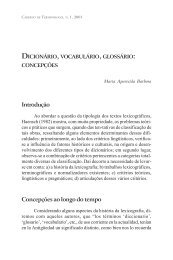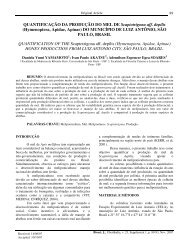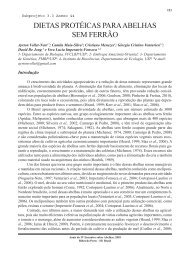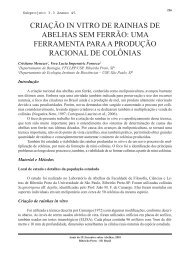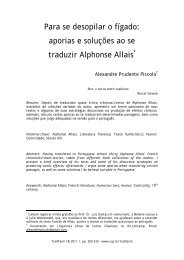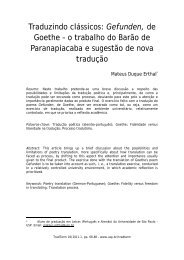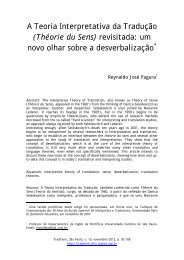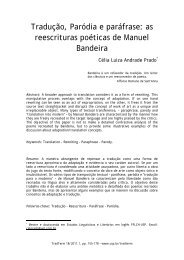Bees as pollinators in Brazil - USP
Bees as pollinators in Brazil - USP
Bees as pollinators in Brazil - USP
You also want an ePaper? Increase the reach of your titles
YUMPU automatically turns print PDFs into web optimized ePapers that Google loves.
• present results by simple summary descriptors,<br />
like species richness, and common and<br />
popular diversity <strong>in</strong>dices;<br />
• feed data b<strong>as</strong>es that provide access to the<br />
general pubic; <strong>in</strong>dicate the collection where<br />
voucher material w<strong>as</strong> deposited.<br />
Monitor<strong>in</strong>g<br />
The proposed exercise for this group w<strong>as</strong> to<br />
give directions for monitor<strong>in</strong>g the impact of<br />
cattle rais<strong>in</strong>g activities on the biodiversity of<br />
<strong>poll<strong>in</strong>ators</strong>. The group started with the statement<br />
of the lead<strong>in</strong>g question: What is the<br />
impact of <strong>in</strong>troduc<strong>in</strong>g cattle “on <strong>poll<strong>in</strong>ators</strong>”?<br />
To address this question, previous data<br />
about bees and their relationship with flowers<br />
of open are<strong>as</strong> will be gathered. This <strong>in</strong>formation<br />
will be used to choose focal groups for<br />
monitor<strong>in</strong>g activities. Preference will be given<br />
to bees sensitive to gradients that are <strong>in</strong> this<br />
c<strong>as</strong>e understood to range from orig<strong>in</strong>al nongrazed<br />
are<strong>as</strong> to heavily grazed are<strong>as</strong>. If prelim<strong>in</strong>ary<br />
data fails to po<strong>in</strong>t out the taxa to be<br />
monitored, the <strong>in</strong>itial monitor<strong>in</strong>g is used to<br />
establish a b<strong>as</strong>el<strong>in</strong>e for further comparisons.<br />
The prelim<strong>in</strong>ary data will be tested for correlation<br />
with desired variables, like bee diversity.<br />
Once a strong and significant statistical relationship<br />
is found, collections will be repeated<br />
through time. The sampl<strong>in</strong>g design is the same<br />
one proposed for the survey, but will be<br />
repeated through time.<br />
HOW DATA FROM MONITORING WILL BE<br />
USED IN THE CONTEXT OF BPI?<br />
Monitor<strong>in</strong>g depends on the choice of sound<br />
and e<strong>as</strong>y to me<strong>as</strong>ure variables. Variable selection<br />
can be made b<strong>as</strong>ed upon previous data. It<br />
is recommended that a selected taxa or a guild<br />
is used for monitor<strong>in</strong>g, but the relationship<br />
between the me<strong>as</strong>ured variable and the object<br />
Workshop I 35<br />
of monitor<strong>in</strong>g should be understood and supported<br />
by a strong significant positive correlation.<br />
Direct relationships are preferred. If the<br />
relation between the me<strong>as</strong>ured variable and<br />
the object of monitor<strong>in</strong>g is not already known,<br />
<strong>as</strong>sumptions must be stated clearly at the<br />
beg<strong>in</strong>n<strong>in</strong>g of the monitor<strong>in</strong>g program. The<br />
selection of a specific taxa or guild must take<br />
<strong>in</strong>to consideration the characteristic that the<br />
focal organisms are abundant and e<strong>as</strong>y to identify.<br />
A previous survey is mandatory for are<strong>as</strong><br />
where data is lack<strong>in</strong>g, to improve the chance of<br />
choos<strong>in</strong>g good taxa to be monitored.<br />
Some general recommendations could<br />
be made for all situations <strong>in</strong>volv<strong>in</strong>g poll<strong>in</strong>ator<br />
surveys and monitor<strong>in</strong>g:<br />
Tra<strong>in</strong><strong>in</strong>g. One problem raised about the use<br />
of “manual” collection methods, such <strong>as</strong><br />
hand-nett<strong>in</strong>g is the effect of different abilities<br />
of different people to f<strong>in</strong>d and capture bees.<br />
This problem can be reduced by properly tra<strong>in</strong><strong>in</strong>g<br />
collectors before actual sampl<strong>in</strong>g is begun.<br />
Replication. An appropriate number of<br />
replicates should be set, accord<strong>in</strong>g to environment<br />
heterogeneity and/or other important<br />
factors. Pseudo-replication should be avoided.<br />
For <strong>in</strong>stance, 12 monthly samples collected at<br />
one site cannot be considered <strong>as</strong> replications<br />
of different disturbance grades or environment<br />
types. In these c<strong>as</strong>es, different are<strong>as</strong> should be<br />
sampled <strong>as</strong> replications of each treatment.<br />
Identification and voucher specimens.<br />
Specimens both of target (<strong>poll<strong>in</strong>ators</strong>) and<br />
<strong>as</strong>sociate (e.g. food sources) taxa should be<br />
properly collected, preserved and labeled to<br />
facilitate proper identification. Such identification<br />
should preferably be done by experienced<br />
personnel. Moreover, voucher specimens of all<br />
taxa <strong>in</strong>volved should be deposited <strong>in</strong> public<br />
collections that should be <strong>in</strong>dicated <strong>in</strong> reports<br />
and publications, so that their identification<br />
can be checked at any time.


